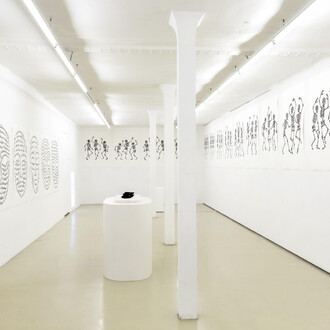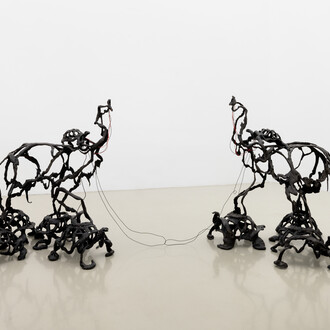If I were a historian or a sociologist, I could explain my undertaking of permanent change with scientific precision. But as it stands, I am left only with the intuitive vagueness of an experience in dealing with art and I do not shy away from advocating for this vagueness, for it is my means of being clear.
Nor am I alarmed by the vagueness of an image, it is precisely this vagueness that becomes the gain in the act of viewing. I can do whatever I want, I can be as clear as I must, and yet any clarity immediately begins to blur.(Oswald Oberhuber, Die permanente veränderung in der kunst, 1958 [Transl. from German])
Under this maxim, the exhibition skulptur - malerei - zeichnung (sculpture - painting - drawing) at Galerie Krinzinger presents three central strands from the extensive oeuvre of Oswald Oberhuber. Like all areas of his work, they are shaped by the principle of permanent change. Oberhuber consistently abandons what has already been found and consciously refuses to commit to a single theme or genre. His guiding principle is the deliberate avoidance of style and liberation from predefined intentions during the creative process.
External influences, which may often occur all of a sudden, play a significant role, to which Oberhuber responds with immediacy and spontaneity. In the post-war period, shaped by his experiences in a National Socialist education camp, he articulated a profound need for freedom. As an important pioneer of Art Informel and with his talent for continually reinventing himself creatively, he significantly influenced the understanding of art in his time. Not least in his role as professor and later rector of the University of Applied Arts in Vienna, he inspired generations of young artists, not by giving them direction, but by urging them to accept none.
Skulptur - malerei - zeichnung is Oswald Oberhuber's eight solo exhibition at Galerie Krinzinger. Since the early years of the gallery, he has been a recurring part of its program. As early as 1971 he was involved in the very first exhibition of the gallery in Bregenz, Aquarelle - druckgrafik - plastik. He was also part of the opening exhibition Aug um aug at the Vienna location in 1986. After this long collaboration, Galerie Krinzinger is now pleased to represent his estate and continue the joint tradition.
The exhibition Skulptur - malerei - zeichnung includes works from various decades, beginning in the 1960s. The works provide insights into Oberhuber's polymorphic oeuvre, which is nourished by permanent change and leaves behind a diverse oeuvre.
















